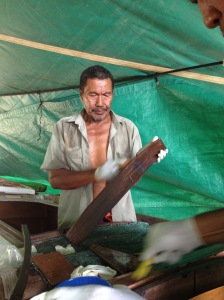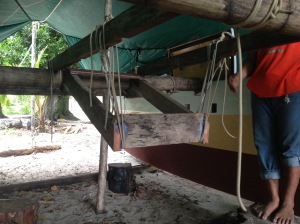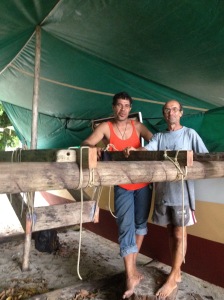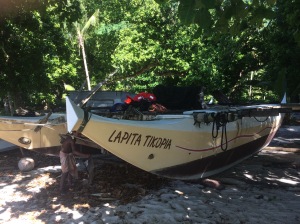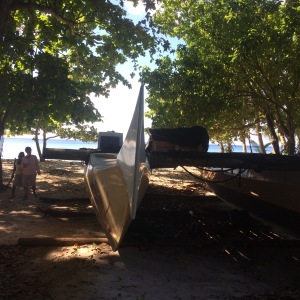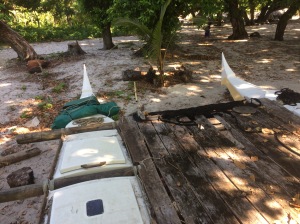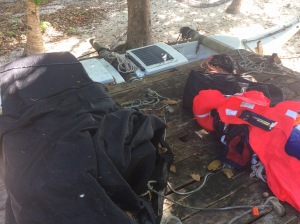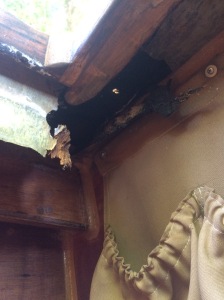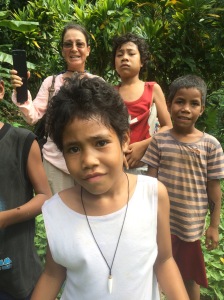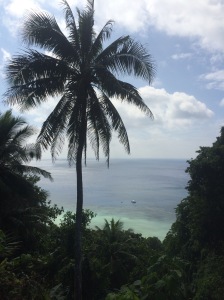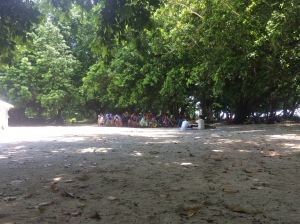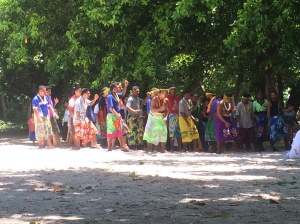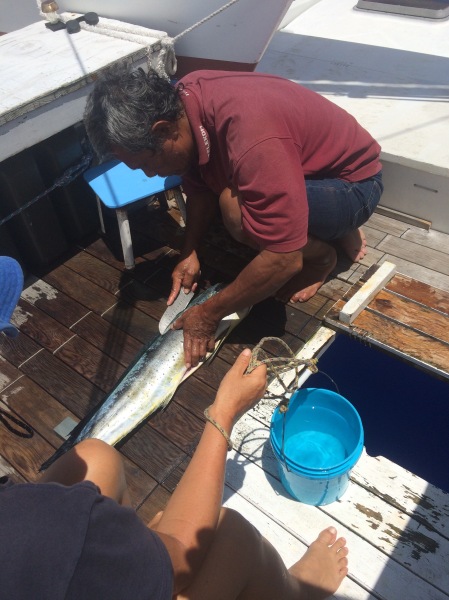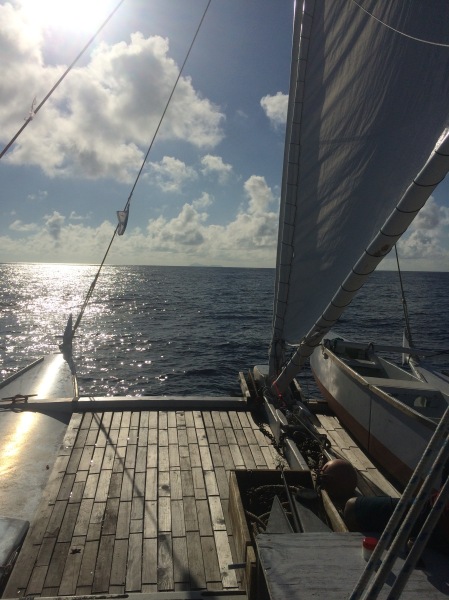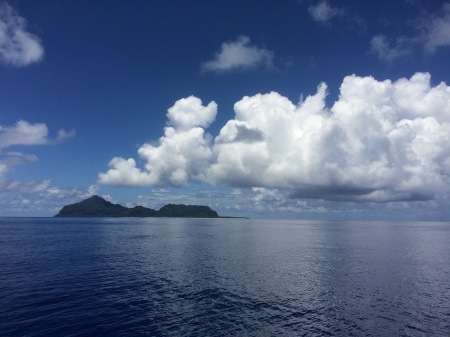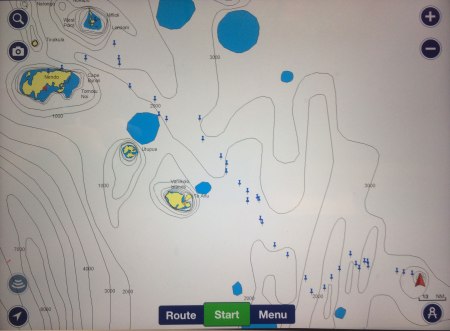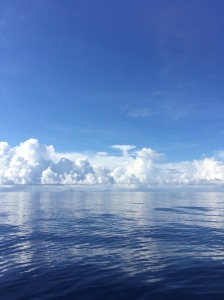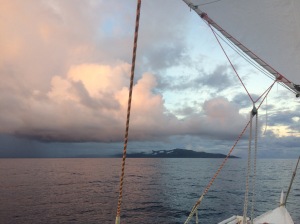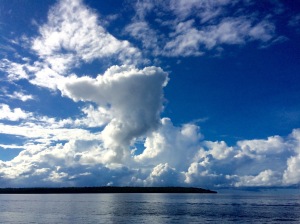Tikopia might seem paradise to the fleeting glimpse of an outside visitor. While its over one thousand inhabitants are living a carefully and smartly controlled life in intimate embrace with nature, modernity has carved a solid foothold right through the middle of it, and the deadly diseases of the consumer society driven by greed and systemic exploitation have grown like cancerous tumours, eating away with lightning speed at its very core. However, as in any other human society, these unfortunate inflictions are diligently hidden away, its weaknesses pushed aside by potent bragging with crippled testosterone, its dark sides kept carefully veiled by well-guarded secrets.
I had contacted Norwegian Thomas Lien by email while still in Luganville, Vanuatu, to get details about the present state of the Lapita canoe. A little over two years ago he had lived for six months on Tikopia with his family of four, hoping to get away from the perils of civilization for a time while producing a television series for kids starring his charming six-year-old daughter. His answers to my persistent questions provided some very helpful information about the technical state of Lapita Tikopia, but once I enquired about the social context and the possible reasons behind the boat’s abandonment, the conversation abruptly stopped.
The two Lapita canoes had been delivered to Anuta and Tikopia in March of 2009. From my detective work on piecing together a history of Lapita Tikopia since then, it seems that for the first three years it was managed by Ariki Tafua’s inner circle, his younger brother Pa Tilo taking on the role of skipper. Four or five trips were made to Lata and back, providing transportation for government officials amongst other lucrative ventures. Pa Tilo is an open hearted guy, with a modern mind tempered by years of working with Solomon Islands fisheries, but leadership is not very high up on his personal skill sheet. Taking advantage of a break during our first week of work on Lapita Tikopia I sat down with him overlooking the bright white sandy beach, which would be an absolutely picturesque scene were it not for the strange fact that this happens to be the Tikopia’s toilet with the dizzying amount of flies that goes along this persistent habit. His account of one of these journeys must stand for most of the others.
‘There were these government officials from Fisheries visiting our island,’ he said in his rather charming intermittently broken English. ‘They needed to return to Lata and suggested why don’t we bring them there with Lapita. They offered a good bit of money. So we went, stopping at the Reef Islands on the way there. Then coming back, I knew we had to go way out to go up into the wind, so I went almost down to the Torres Islands. That’s when my crew started to complain, asking why we go that far and why don’t we head for Tikopia. After four days we finally sighted Tikopia, but they said it was a different island. Then I was sleeping down in the cabin when I heard the sails bang about on top. I went up and nobody was looking after things. Everybody wanted to know better than me, but when it came to doing things they were hopeless. We finally made it back but then they didn’t want to sail with me anymore.’
By 2012 it appears that accusations started to rummage about in the island. That the Tafua clan was making a lot of money with the canoe, that it should be the property of all the island folks, why don’t they share the profits and other similar things. After a while Ariki Tafua, at the time the present chief’s father Edward, gave in and transferred ownership to a steering committee in the neighboring village of Saint Michael. More trips were made but the moneys earned ended up carelessly in private pockets instead of being reinvested in the maintenance of the boat. It looks as the Solomon Island disease of corruption and misuse of public funds and property has made great inroads in Tikopia as well. On one of the last trips in 2014 the foot of the main mast broke and repairing that proved to be too great a feat for the designated captain and crew. No more use was made of the sailing canoe and not only was there nobody looking after it anymore, but things started to disappear from it, probably to mend more urgent personal needs somewhere else on the island.
These two years of abandonment were now at our hands and I was doing my best to explain again and again that I had not come to do the work myself. From our first meeting with the three chiefs I had demanded working hands, skilled and unskilled, ideally from the different villages on the island, to come and help with the restoration of the canoe, so that a sense of communal ownership could be reestablished. This took a good week and a further visit to Ariki Kafika in Ravenga on a rainy Sunday to sink in to the realm of reality. By week two a small team of four of five constant helpers and a short list of intermittent appearances had materialized. The rotten wood was being scraped out from underneath the fiberglass of the decks and pieces of the miserable plywood we found at the local school were cut to be fitted back in.
As was to be expected progress was terribly slow and the original optimistic goal of sailing to Vanikoro together with us on Aluna at our return to Lata by the end of the month soon had vanished into very thin air. But soon our new island friends were mixing epoxy with cheap Latex gloves on their big hands. Their work was far from a pretty sight with blobs of hardened glue all over the place. Pretty was not what we were after however, and at the start of our third week on Tikopia, the coaming of the worst affected hatch was being reinstalled. Locally cut timber started to appear at the sight to be transformed into new bearers for the deck platform. Ariki Tafua had generously donated a sturdy bed frame from one of his guest houses. This provided good quality timber for replacing the rotten parts in the hull sides. New pieces for the hinges were being cut out and shaped by a very tall and viscously skilled wood worker. On good days food was being prepared by nearby families for the work crew and the constant supply of beetlenut and tobacco kept things moving along.
It was now the last week of our stay, the end of October was approaching and with that the onset of the cyclone season. The repair of the worst section of the hull decks was almost completed and I designed a new motor bracket to mount the 15hp engine that had been donated by the Tikopia member of parliament. This in fact was a bit of an engineering challenge of its own, as it had to be done crudely without any fancy blocks and tackle. I keep my fingers crossed that it will work in the harsh reality of maritime abuse. While there was still a good amount of work to be done, a solid beginning had been made.
Figuring out what had gone wrong in the past beyond the general notion of money and accessories of the canoe mysteriously disappearing, proved to be an impossible task. The present Tikopia society is one in disarray. Modernity is overrunning the island at a time when three of the four chiefs had to fill the shoes of their fathers at a very young age, while the fourth is clearly losing his wits to old age. With the money economy infiltrating the island’s social fabric at breakneck speed, the power of decision making is sifting through the stunned fingers of the immature chiefs towards the more astute, and discontent and distrust is growing along the fuzzy lines of clanships like mold and moss in the tropical heat. Nobody I managed to talk to had the courage to speak out against the chief’s clan or give clear cut information about the whos and the hows of the managerial catastrophe that had stifled the sound development of Lapita Tikopia.
Against all odds Ariki Tafua seems determined to give Lapita Tikopia a second life. That there may be a good deal of self-interest fueling his resolve does not matter all that much in the destined evolution of things. Given the lack of interest demonstrated by his fellow Tikopia citizen, it might in fact be the canoe’s only chance of survival. The very visible truth is that the Tikopia have made a firm step into the modern day consumer society. Money and its distorted evaluation of reality is infiltrating the merry minds of these charming island folks like a viral outbreak of contagious disease under the burning tropical sun. Maybe the burgeoning middle class haunted by their very recent stone age past will sooner or later claim some or all of the properties of the flailing chiefly clans and in a neo-liberal take-over Tikopia style realize, in appearance at least, the communal intentions of the original donors of the canoe. That can and will of course happen only once the hard work of restauration from the past neglect has been accomplished, once the profits promise to be smooth and fat and sufficiently effortless…



